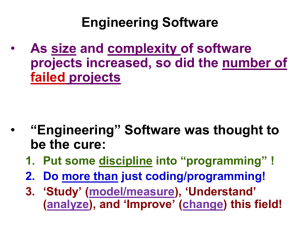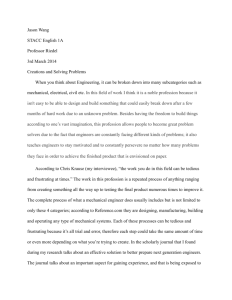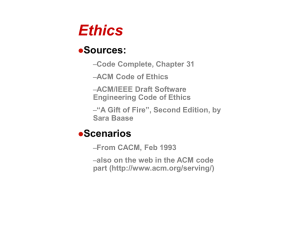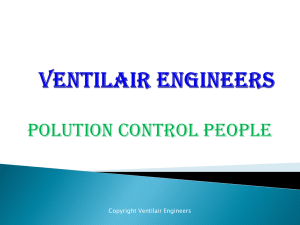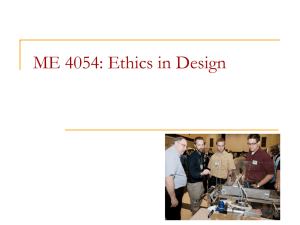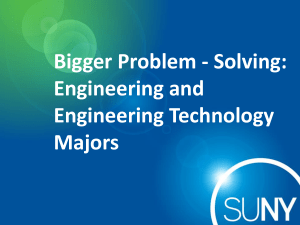Engineering Software - Longwood University Computer Science
advertisement
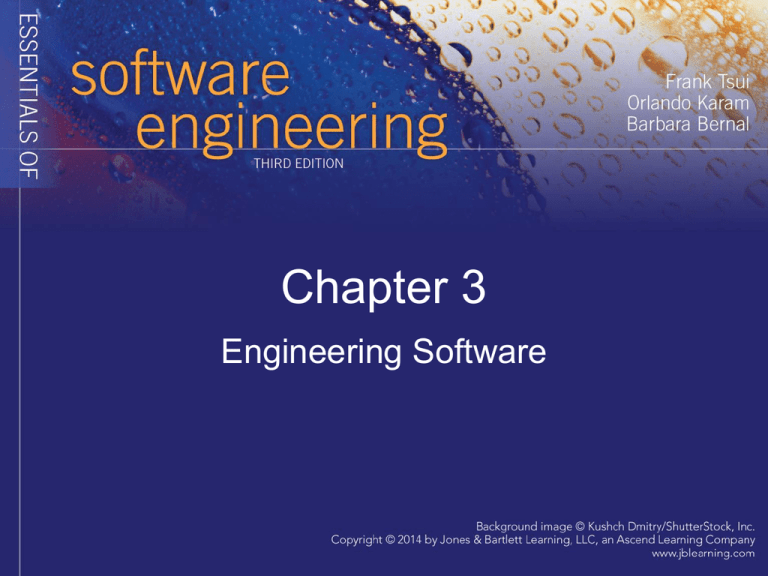
Chapter 3 Engineering Software Engineering Software • As size and complexity of software projects increased, so did the number of failed projects • “Engineering” Software was thought to be the cure: 1. Put some discipline into “programming” ! 2. Do more than just coding/programming! 3. ‘Study’ (model/measure), ‘Understand’ (analyze), and ‘Improve’ (change) this field! Chaos Report and Software Project Success/Failures • Chaos Report (1995) sampled some 300 software projects and reported that only about 16% of those projects “completed,” “on-time,” and “within-budget” ! That is 84% of projects failed! • Chaos Report (2009) stated that software projects have improved with 32% “completed,” “on-time,” and “within-budget.” That is still 68% of projects-failure! Software Project Success & Failure Factors (Chaos Report) • Profiling attributes for projects that “succeeded”: – – – – User Involvement Executive Management Support Clear Requirements Proper Planning • Profiling attributes for “challenged” (completed & operational – but over-budget and over-time-estimate) – Lack of user input – Incomplete user requirements and specification – Changing requirements and specifications • Profiling attributes for “impaired and ultimately cancelled” – Incomplete requirements – Lack of user involvement – Lack of resources Software Product Failures (Capers Jones Study) • • • • • Code errors : Design errors : Documentation errors : Requirements errors : Bad-fix errors : 38.33% 24.17% 13.33% 12.50% 11.67% All errors can be serious and very costly but -Should we worry about coding more or requirements more, -- why? Requirements errors are very “costly” if not detected & left in the product –Why? Coordination & Non-Technical Concerns • As software projects grew in size and complexity, problems went beyond just code and software. Other “non-technical” issues became apparent: 1. Executive commitment and leadership 2. Thorough planning of both business and technical processes 3. Skilled and experienced work-force 4. Management focus and project monitoring 5. Willingness to make changes and adjustments US General Accounting Office Report to US Senate (2004) • 3 “Key” strategies to ensuring delivery of: – – – a) high quality software b) on-time and c) within-budget: 1. Focused attention on software development environment (people/tools/management/etc.) 2. “Disciplined” development process 3. Methodical use of metrics to gauge cost, schedule, and functional performance targets “Birth” of Software Engineering • The early experiences of writing difficult but “small programs” did NOT provide us with the road map when we started to build “large” operating system, database, commercial system, etc. • What is needed to develop large and complex software “products” and what is needed to control such projects ? • More “discipline” is needed in this field: – “SOFTWARE ENGINEERING!!!” (NATO conference - 1968) What is Software Engineering? • David Parnas – multi-person construction of multi-version software • Sommerville – “an engineering discipline whose focus is the cost-effective development of high quality software system” • Pfleeger – application of computing tools to solving problems • CMU/SEI-90-TR-003 – “form of engineering that applies the What are these?? principles of computer science and mathematics to achieving cost-effective solutions to software problems • IEEE std 610-1990 – “application of a systematic, disciplined, quantifiable approach to the i) development of, ii) operation of, and iii) maintenance of software” Curriculum Guideline: “ creating high quality software in a systematic, controlled, and efficient manner ” Software Engineering (Tsui and Karam) • Software Engineering is a broad field that touches upon all aspects of a) developing and b) supporting a software system, spanning across the following key areas: 1. Technical and business processes 2. Specific methodologies and techniques 3. Product characterization and metrics for measurements 4. People skills and team work 5. Project coordination and management Relevancy of Software Engineering • Software is a serious business – Reached $180 billion in 2000 – It is ubiquitous across multiple industries • Software is a commodity of increasing “Value” • The business of software has graduated from a “garage” operation to an “enterprise” profession ----- including recent “Facebook” • We need to treat software engineering as an engineering profession • 15 universities have received accreditation (2009) from accreditation board of engineering and technology Software Engineering “Professionals” • There is no equivalent “professional engineer” (PE) designation for software engineers, yet. – Except in Texas where the board of professional engineers adopted software engineering as a specific discipline under which en engineering license may be issued. So -- how do we become more “professional” in Software Engineering Any More Guidance? IEEE-CS/ACM Version 5.2 Report • 8 principles** for ethics and professional practices in software engineering – Software engineers shall act consistently with the public interest – Software engineers shall act in a manner that is in the best interest of their client and employer, consistent with the public interest – Software engineers shall ensure that their products and related modifications meet the highest professional standards possible – Software engineers shall maintain integrity and independence in their professional judgment – Software engineering managers and leaders shall subscribe to and promote an ethical approach to the management of software development and maintenance – Software engineers shall advance the integrity and reputation of the profession consistent with the public interest – Software engineers shall be fair to and supportive of their colleagues – Software engineers shall participate in lifelong learning regarding the practice of their profession and shall promote an ethical approach to the practice of the profession. ** Under each of these major principles, there are further sub-principles. A “Simpler” Set of Behavioral Rules • Respect others • Strive for fairness • Perform to one’s best capability • Follow the law “General Principles” • Different from other engineering disciplines such as civil or mechanical, there is no one set of “universal principles” in software engineering that is agreed to by everyone. Neither is there any “law” of software engineering such as Newton’s law of motion in physics • There are, however, several that are well received and respected. – Davis’s Principles – Royce’s Principles – Wasserman’s Concepts Davis’s Early 15 principles 1. 2. 3. 4. 5. 6. 7. 8. 9. 10. 11. 12. 13. 14. 15. Make quality number 1 High quality software is possible Give products to customers early Determine the problem before writing the requirements Evaluate design alternatives Use an appropriate process model Use different languages for different phases Minimize intellectual distances Are these consistent within themselves -Put techniques before tools How “key” is “people are key Get it right before you make it faster to success” Inspect code What do you think? Good management is more important than good technology People are the key to success Follow with care Take responsibility Royce’s More “Modern” set of Principles 1. 2. 3. 4. 5. 6. 7. 8. 9. 10. Base the process on an architecture first approach Establish iterative process --- address risk early Emphasize component-based development to reduce effort Establish change management Use round-trip engineering – a form of iterative process Use model-based and machine processable notations for design Establish process for quality control and project assessment Use approach that allows artifacts to be demonstrated early Plan to have incremental releases Establish a configurable process to suit the needs Agree with these? Why ? Wasserman’s Fundamental Concepts 1. 2. 3. 4. 5. 6. 7. 8. Abstraction Analysis and design methods and notation User interface prototyping Modularity and architecture Reuse Life cycle and process Metrics Tools and integrated environment Important concepts -- how do they relate to earlier listed the principles from Davis or Royce? These “Principles” Address the earlier mentioned • 3 “Key” strategies to ensuring delivery of: – – – a) high quality software b) on-time and c) within-budget: 1. Focused attention on software development environment (people/tools/management/etc.) 2. “Disciplined” development processes 3. Methodical use of metrics to gauge cost, schedule, and functional performance targets

